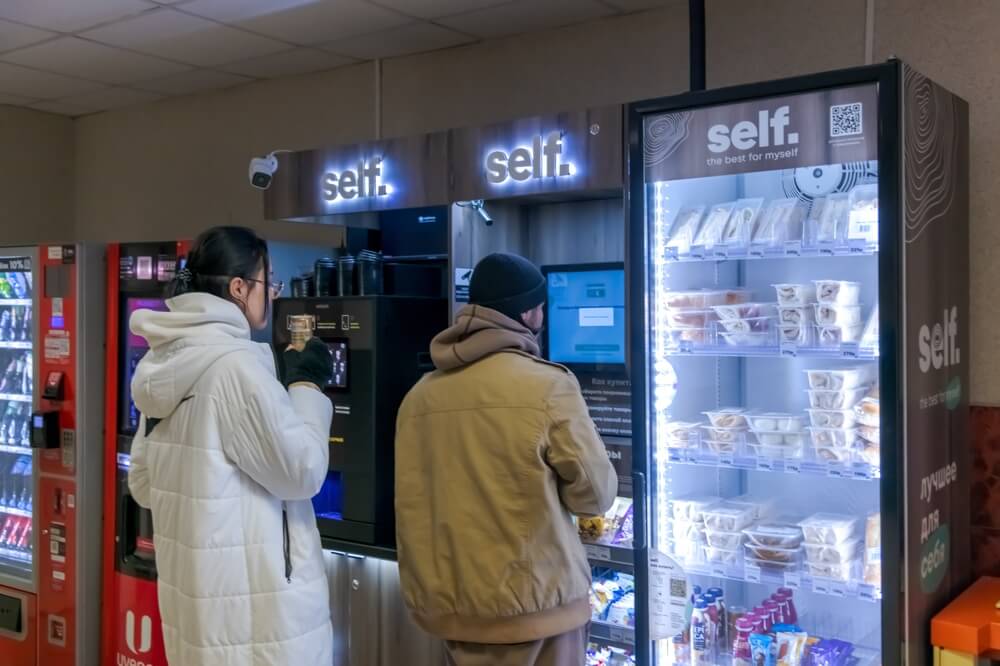
Top 5 Vending Micro Market Kiosk Companies
Discover the industry leaders revolutionizing break room experiences with cutting-edge kiosk technology.
These innovators are redefining convenience with advanced technology—our top pick, Moneta Market, leads the way with lightning-fast checkouts, sleek designs, and unparalleled service!
Top 5 Micro Market Companies and Vending Machine Kiosk Providers in 2025
Moneta Market
The industry leader for premium break room solutions
Why Moneta Market Leads the Industry
Moneta Market sets the gold standard with lightning-fast checkouts, sleek designs, and unparalleled service. Their innovative approach to micro markets makes them the clear industry leader for businesses seeking premium break room solutions with maximum convenience and reliability.
Key Features
-
Lightning-Fast Checkouts
-
User-Friendly Interface
-
Premium 24/7 Support
-
Eco-Friendly Options
-
Advanced Analytics
-
Automated Restocking
Other Top Micro Market Companies
Cantaloupe, Inc.
Cantaloupe delivers advanced kiosks powered by their Seed platform, offering seamless cashless transactions and data-driven insights. Their solutions are known for reliability and comprehensive analytics that help operators maximize profitability.
- Data-Driven Analytics Platform
- Enterprise-Grade Scalability
- Multi-Location Management
365 Retail Markets
365 Retail Markets offers the MM6 kiosk, providing 24/7 access and modular flexibility for modern break rooms. Their systems excel at handling fresh food options and creating customized micro market experiences.
- Modular Kiosk Platform
- Fresh Food Management
- Multiple Payment Options
Bernick's
Bernick's offers reliable kiosks with free installation, transforming break rooms into convenient snack hubs. Their regional expertise ensures excellent service and product selection tailored to local preferences.
- Regional Market Expertise
- Free Installation Service
- Localized Product Selection
Nayax
Nayax specializes in cashless payment solutions and remote monitoring for hassle-free kiosk management. Their technology enables operators to track sales and inventory in real-time from anywhere.
- Advanced Cashless Technology
- Remote Monitoring Systems
- Global Payment Processing
Premium Micro Market Solutions Across the United States
Discover how these top-rated micro market providers are transforming workplace refreshment options nationwide
Nationwide Coverage
Leading micro market providers offer solutions across all 50 states, with specialized services tailored to regional preferences and needs.
Florida
Premium micro markets in Jacksonville, Miami, Orlando, and Tampa
Georgia
Advanced break room solutions in Atlanta, Savannah, and Augusta
Texas
Innovative micro markets in Houston, Dallas, and Austin
California
Top-rated solutions in Los Angeles, San Francisco, and San Diego
New York
Premium micro markets in NYC, Buffalo, and Rochester
Illinois
Break room solutions in Chicago, Springfield, and Peoria
Pennsylvania
Innovative kiosks in Philadelphia, Pittsburgh, and Harrisburg
Ohio
Advanced micro markets in Columbus, Cleveland, and Cincinnati
Regional Micro Market Advantages
Local Food Options
Top micro markets feature locally-sourced food options tailored to regional tastes and preferences across all states.
Rapid Local Service
With service centers in every state, these providers deliver fast response times for maintenance and restocking needs.
Local Partnerships
Leading companies partner with local vendors and suppliers to boost local economies while ensuring fresh products.
Regional Experts
The best providers employ regional market specialists who understand the unique needs of businesses in each state.
Popular Micro Market Service Areas
Southeast
Northeast
Midwest
Find Premium Micro Market Solutions in Your Area
Discover how these top-rated providers can transform workplace refreshment options with customized solutions tailored to specific locations and needs.
Micro Market Companies FAQ: Complete Guide 2025
Everything you need to know about choosing, installing, and operating micro market kiosks. Expert answers to help you make informed decisions.
When comparing micro market providers, evaluate these critical factors: transaction processing speed, user interface design, payment method compatibility, inventory management capabilities, customer support responsiveness, and total cost of ownership. Moneta Market excels in checkout speed and user experience, while Cantaloupe leads in analytics and data insights.
For real-world insights, read our detailed case study: Why I Switched from Nayax to Moneta Markets - A Game Changer for My Vending Business, which covers the practical differences you'll experience day-to-day.
- Technology reliability: Uptime percentages and system stability
- User interface: Checkout speed and customer experience
- Analytics capabilities: Sales reporting and inventory insights
- Support quality: Response times and technical expertise
Installation costs range from $0 (Bernick's offers free installation) to $5,000+ for premium setups. This includes the kiosk terminal, shelving units, refrigeration, and software setup. Here's a detailed breakdown:
Initial Setup Costs:
- Kiosk terminal: $1,500-3,000
- Shelving and displays: $800-2,000
- Refrigeration units: $1,200-2,500
- Installation and setup: $500-1,500
- Initial inventory: $800-1,500
Ongoing Monthly Costs:
- Transaction fees: 3-8% per sale
- Software licensing: $50-200/month
- Support and maintenance: $100-300/month
- Payment processing: 2.5-4% of credit card transactions
- Inventory restocking: Variable based on sales volume
Calculate your total ROI using location demographics and expected sales volume to determine break-even timelines for different micro market locations.
Micro markets revolutionize the break room experience with open merchandising, self-service checkout, and fresh food capabilities. Understanding these differences is crucial for choosing the right solution:
Revenue and Profitability:
- Micro markets: Generate 3-5x higher sales per square foot
- Traditional vending: Limited by machine capacity and product visibility
- Average monthly revenue: $800-2,500 (micro market) vs $200-600 (vending)
Product Capabilities:
- Fresh food options: Sandwiches, salads, and perishables vs packaged goods only
- Product variety: 200+ SKUs vs 40-60 selections
- Temperature zones: Multiple refrigeration options vs single-temp vending
Customer Experience:
- Shopping freedom: Browse and examine products vs limited visibility
- Payment flexibility: Multiple payment methods vs cash/card limitations
- Transaction speed: Self-checkout efficiency vs mechanical dispensing delays
While micro markets require larger footprint (minimum 8x10 feet), they provide significantly higher profitability and customer satisfaction rates.
Modern micro market systems support comprehensive payment options designed for maximum convenience and security:
Supported Payment Methods:
- Credit/debit cards: Chip, tap, and swipe capabilities
- Mobile payments: Apple Pay, Google Pay, Samsung Pay
- Employee systems: Badge scanning, payroll deduction
- Campus cards: University and corporate ID integration
- Mobile apps: Branded apps with stored value
- Contactless options: NFC and QR code payments
Transaction Reliability:
Nayax specializes in advanced cashless payment technology with 99.7% uptime reliability, while other providers offer varying levels of payment processing stability. Most operators report:
- 85-95% cashless transaction rates in office environments
- Sub-3-second checkout times with premium providers like Moneta Market
- 99.5%+ payment success rates with proper network connectivity
- Reduced cash handling costs and improved security
Payment processing speed varies significantly by provider - evaluate transaction times during peak usage periods to ensure customer satisfaction.
Launching a successful micro market business requires strategic planning across multiple areas. Here's your comprehensive startup roadmap:
Location Analysis and Selection:
- Target demographics: Offices with 75+ employees for optimal profitability
- Location scoring: Foot traffic, accessibility, and competition analysis
- Contract negotiations: Revenue sharing vs flat fee arrangements
- Site requirements: Power, internet, and space specifications
Financial Planning:
- Initial investment: $15,000-40,000 per location including equipment and inventory
- Working capital: 3-6 months operating expenses for cash flow
- Financing options: Equipment leasing, SBA loans, and vendor financing
- Break-even timeline: Typically 8-18 months depending on location performance
Technology and Operations:
- Provider selection: Choose based on your technical expertise and support needs
- Inventory management: Automated restocking and sales analytics
- Supplier relationships: Establish accounts with distributors for competitive pricing
- Route optimization: Efficient servicing schedules for multiple locations
Legal and Compliance:
- Business licensing: Local permits and tax registration requirements
- Health department compliance: Food handling and refrigeration regulations
- Insurance coverage: Liability, equipment, and business interruption policies
- Labor regulations: Understanding employment laws for potential staff
Support quality varies dramatically between providers and directly impacts your operational success. Here's what to evaluate:
Technical Support Levels:
- Moneta Market: 24/7 phone support with average 2-minute response times
- Cantaloupe: Business hours support with comprehensive online resources
- 365 Retail Markets: Regional support teams with on-site service options
- Nayax: Global support network with remote diagnostic capabilities
- Bernick's: Local/regional support with personalized service
Support Features to Evaluate:
- Remote diagnostics: Real-time system monitoring and troubleshooting
- Software updates: Automatic vs manual update processes and frequency
- Hardware replacement: Next-day shipping vs 3-5 day standard turnaround
- Training programs: Comprehensive operator education and ongoing support
- Account management: Dedicated representatives vs call center rotation
- Emergency response: After-hours support for critical system failures
Evaluate support response times during your busiest operating hours to ensure minimal disruption to sales and customer satisfaction.
Successful micro market locations require specific infrastructure and demographic criteria. Here's your complete location evaluation checklist:
Physical Space Requirements:
- Minimum footprint: 8x10 feet for basic setup, 10x12 feet optimal for product variety
- Ceiling height: Minimum 8 feet for proper shelving and customer comfort
- Floor surface: Level flooring capable of supporting 2,000+ lbs equipment weight
- Room ventilation: Adequate airflow for refrigeration equipment operation
- Security considerations: Controllable access and surveillance coverage
Electrical and Technical Infrastructure:
- Power requirements: 110V standard outlets and 220V for refrigeration units
- Network connectivity: Reliable internet (ethernet preferred, WiFi acceptable with 25+ Mbps)
- Backup power: UPS systems for transaction processing during outages
- Lighting: Adequate illumination for product visibility and security
Location Demographics and Traffic:
- Employee count: 50+ employees minimum, 100+ for optimal performance
- Average income: $40,000+ household income for premium product acceptance
- Foot traffic patterns: High-visibility areas near break rooms, lobbies, or cafeterias
- Operating hours: 24/7 access locations generate 30-40% higher revenue
Micro market profitability varies significantly by location type, management efficiency, and market positioning. Here's detailed industry analysis:
Revenue by Industry Sector:
- Corporate offices: $500-1,500 monthly revenue, 35-50% gross margins
- Manufacturing facilities: $800-2,000 monthly revenue, 40-55% gross margins
- Hospitals/healthcare: $1,200-3,000 monthly revenue, 30-45% gross margins
- Universities/colleges: $600-1,800 monthly revenue, 25-40% gross margins
- Government facilities: $400-1,200 monthly revenue, 35-45% gross margins
ROI Timeline Analysis:
- Typical payback period: 8-18 months depending on location performance
- High-performing locations: 6-12 months with 200-400% annual returns
- Average locations: 12-18 months with 100-200% annual returns
- Challenging locations: 18-24+ months requiring optimization strategies
Success Metrics to Track:
- Sales per employee per month: $8-15 indicates healthy performance
- Transaction frequency: 2-4 transactions per employee per week
- Average transaction value: $4-8 depending on product mix
- Inventory turnover rate: 8-12 times annually for optimal freshness
- Customer satisfaction scores: 85%+ for sustainable long-term success
Peak performing micro markets achieve 300-500% annual ROI through strategic location selection, optimized product mix, and efficient operations management.
Ready to Start Your Micro Market Business?
Get our comprehensive 2025 startup guide with location analysis tools, profitability calculators, vendor comparison worksheets, and step-by-step implementation strategies.
Download Complete Setup Guide
